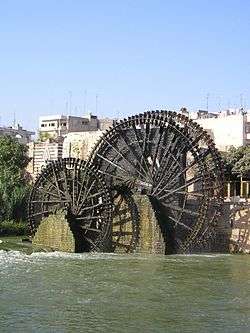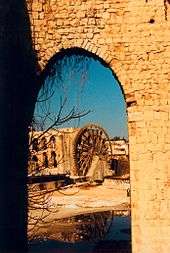Norias of Hama
The Norias of Hama (Arabic: نواعير حماة) are a number of norias ("wheels of pots") along the Orontes River in the city of Hama, Syria. Only seventeen of the original norias remain. They are mostly unused now and serve an aesthetic purpose. They were called "the most splendid norias ever constructed".[1] The norias of Hama were submitted as a tentative World Heritage Site by the Syrian Arab Republic in June 1999.[2]

History
The earliest evidence for norias in Hama suggests they were developed during the Byzantine era, although none of the norias in Hama today precede the Ayyubid period (12th/13th centuries). However, a mosaic found at Apamea dating to 469 A.D. pictures a noria similar to those at Hama, suggesting they may have earlier origins.[3] The surviving norias date back to the medieval Islamic period, when norias as large as 20 metres in diameter were built, with 120 water collection compartments and capable of raising more than 95 litres of water per minute.[4] Now only 17 norias remain, unused.[5]
Gallery
 The Water Wheel of Hama
The Water Wheel of Hama Al-Na‘urah al-Muhammadiyah at the beginning of the 20th century
Al-Na‘urah al-Muhammadiyah at the beginning of the 20th century
References
- Needham and Ronan, 1995, p.281.
- https://whc.unesco.org/en/tentativelists/1291
- Adriana De Miranda (2007). Water Architecture in the Lands of Syria: The Water-wheels. L'ERMA di BRETSCHNEIDER. pp. 53–. ISBN 978-88-8265-433-7. Retrieved 24 August 2012.
- "Machines of the East". Ancient Discoveries. Season 3. Episode 10. History Channel. Retrieved 2008-09-07.
- Ring, Berney, Salkin, La Boda, Watson, and Schellinger, 1996, p.137-138.
Bibliography
- Ring, Trudy; Berney, K.A.; Salkin, Robert M.; La Boda, Sharon; Watson, Noelle; Schellinger, Paul (1996), International Dictionary of Historic Places: Middle East and Africa, Routledge, ISBN 1-884964-03-6.
- Needham, Joseph; Ronan, Colin A. (1995), The Shorter Science and Civilisation in China: Volume 5, Cambridge University Press, ISBN 0-521-46773-X.